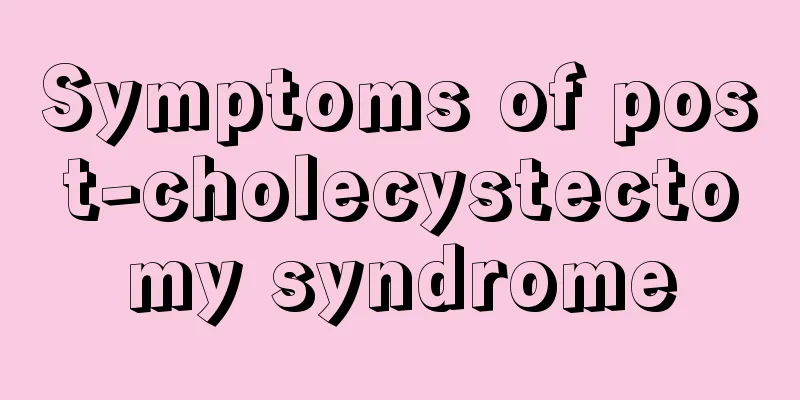Symptoms of post-cholecystectomy syndrome

|
Cholecystectomy is a common surgical operation, with good results in most patients. However, in a small number of patients, the original symptoms persist or reappearance of upper abdominal discomfort, dull pain, indigestion and other symptoms after cholecystectomy. This is often referred to clinically as post-cholecystectomy syndrome. Most scholars believe that it occurs 1, 5 to 6 years after surgery, while some scholars believe that it can occur at any time after surgery, and the reasons are more complicated. Clinical manifestations: Half of PCS patients experience abdominal pain or "dyspepsia" (fullness in the upper or right upper abdomen, borborygmus, nausea, vomiting, constipation, fat intolerance, or diarrhea) within a few weeks after surgery, while the other half experience symptoms months or years after surgery. These symptoms are nonspecific and vary depending on the underlying cause, but often include pain in the right upper abdomen or epigastrium, which is often sharp after meals. Other symptoms may include heartburn, belching, vomiting, and intolerance to fatty foods. A few patients may have severe cholecystitis or pancreatitis, with severe pain and possibly fever, jaundice, or vomiting. Examination of such patients is more likely to reveal a specific disorder than that of patients with mild or no specific symptoms. Physical examination is usually of no particular value except for the detection of obvious jaundice. complication: 1. Other comorbidities Nearly 1/3 of patients did not undergo a detailed examination before cholecystectomy, and some symptoms were ignored and only diagnosed as gallbladder disease, and then cholecystectomy was performed. The common ones are as follows: (1) reflux esophagitis, hiatal hernia; (2) gastric diseases such as gastric ulcer and gastritis; (3) duodenal lesions such as papillitis and parapapillary diverticulum; (4) pancreatic diseases such as chronic pancreatitis and tumors. First of all, they should be differentiated. As long as the possibility of these diseases is considered, the relevant medical history should be carefully inquired and relevant examinations should be performed, such as CI, gastrointestinal endoscopy, B-ultrasound, CT, etc. 2. Biliary tract motility disorder Under normal circumstances, the smooth muscle of the bile duct is regulated by nerves and humors, and gastrointestinal hormones and nerve impulses work together to harmoniously regulate the contraction and relaxation of different parts of the bile duct. For example, after eating, the gallbladder smooth muscle contracts and the Oddi sphincter relaxes, thereby promoting bile to enter the duodenum and participate in digestion. After cholecystectomy, this balance is disrupted. Most patients are able to adapt and compensate for this balance through neurohumoral mechanisms. A few patients have difficulty adapting. Some examinations have found that the pressure of the Oddi sphincter increases and the frequency of contraction increases. After eating, the secretion of gastrointestinal hormones cannot be inhibited by feedback and increases, causing abnormal contraction or spasm of the bile duct smooth muscle, resulting in abdominal pain. The symptoms of such patients will disappear after taking oral anti-inflammatory and choleretic drugs. 3. Residual stones in the common bile duct The main reason is missed diagnosis before surgery, followed by gallstones sliding into the common bile duct or intrahepatic stones being discharged into the common bile duct during the operation. If the common bile duct stones are not found before or during surgery, and patients develop biliary colic accompanied by jaundice, fever, and Chancut's triad after surgery, the best diagnostic methods are MRCP and ERCP. Once confirmed, the best method is endoscopic papillotomy (EST) to remove the stones, otherwise another surgery is required. |
<<: Is it possible to have a natural birth with gallbladder cancer?
>>: What are the symptoms of advanced liver metastasis of gallbladder cancer
Recommend
I ejaculated outside and cleaned it up immediately
If you clean the semen immediately after ejaculat...
I feel dizzy and about to fall down. What's going on?
I believe many people have experienced standing i...
The person next to you snores loudly. Here are 7 tips to help you fall asleep
According to the Popular Health Network, there ar...
How can I cure snoring?
Snoring seems to be a minor problem and is a comm...
What should patients with esophageal cancer pay attention to in terms of diet?
Esophageal cancer itself is a digestive system di...
What are the typical symptoms of patients with early lung cancer? Several typical symptoms of early lung cancer
Experts say that the early symptoms of lung cance...
Effects of Huaishu Honeysuckle Cleansing Water
Honeysuckle is a very familiar traditional Chines...
What are the dangers of kidney cancer? What are the symptoms of kidney cancer?
Kidney cancer can cause physical and psychologica...
Causes of catalyst poisoning
I don’t know if you have ever experienced catalys...
What to do if you feel hungry before going to bed
People usually feel hungry before going to bed, a...
Which hospital should I go to if I have endometrial cancer
Everyone knows that endometrial cancer is a commo...
What is the role of Taekwondo?
Taekwondo is a self-defense martial art introduce...
Can I take honey and medicine together?
Recently, I saw a very practical topic on the Int...
Is it dangerous to get pregnant and have a baby with colon cancer?
Once a malignant tumor disease such as colorectal...
Washing down jackets in a drum washing machine
Many women like summer because the arrival of sum...









